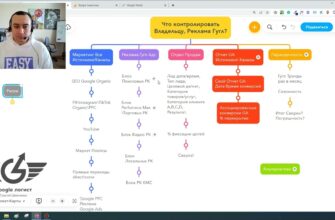- What do you need to run ad campaigns on WordPress?
- Briefly about the stage of Merchant Center establishment
- About Google Listings & Ads plugin for WordPress
- Installing the Google Listings & Ads plugin
- Setting up accounts in the Google Listings & Ads plugin
- Customizing the “Audience” block
- Customizing delivery conditions
- Providing a telephone number and address
- Setting up a campaign with paid advertising
- Creating paid advertising campaigns in Google Listings & Ads
- Setting up a feed in Merchant Center
- Checking the specified delivery parameters
- Tax parameters
- Checking the block of business information
- Other store business information
- Results of Merchant Center setup
- Announcement of the next video – creating analytics, Google Ads
Hi! My name is Yana Lyashenko, Google logistician. I’m in charge of delivering targeted audience to businesses with the right parameters. In today’s video I will show the whole process from start to finish of how to run Performance Max or Google Shopping on WordPress or more correctly WooCommerce. More precisely there are those who use the concept of WooCommerce.
What do you need to run ad campaigns on WordPress?
What you need to run trade advertising campaigns anywhere in the world directly on WordPress. You only need three things to do this. First – you need a Merchant Center configured with goods, passed moderation, now we will serve what it is. Secondly, you need to set up a Google Ads advertising office, nothing complicated. We will use it to start advertising directly. The third thing is to set up analytics correctly. Analytics includes several sub-stages. Let’s customize each of the items that will be needed in the future. I’ll tell you what that item is for. All the timecodes are down below.
Briefly about the stage of Merchant Center establishment
What do you need to set up directly Performance Max or Google Shopping on WordPress in WooCommerce? The first thing to start with is directly creating the Merchant Center. This is one of the longest stages. Why long? Moderation of items will take a certain chunk of time. What is Merchant Center? Merchant Center is a separate service from Google, in which we fill in information about products and store, not particularly large. In this service Google checks us. It checks whether or not to allow us to advertise. Difficulties may arise – if the site is poorly designed, lacks basic information, is inconvenient or other, it may be rejected. The domain will be blocked, you will have to suffer with re-moderation. We are missing this point, it’s a completely different story.
How many calls and sales will I get by ordering contextual advertising from you?
I need to calculate the conversion of my website Describe
the task
in the application
Calculate potential ad revenue Google
contextual advertising calculator
Most people have a pretty good situation. Long period as moderation, checking of goods can take up to 72 hours. About 3 days. That’s why it’s called the longest phase. Everything else is fairly quick.
About Google Listings & Ads plugin for WordPress
Where can I start setting up Merchant Center? In the video I will show the simplest and free, such a bum-option how to go through everything, customization, I will use those tools, plugins that are absolutely free, easily installed on WordPress in WooCommerce and that everyone can use. If you found something analog paid, better – no problem you can use it. As they say, I show the most free and severe option.
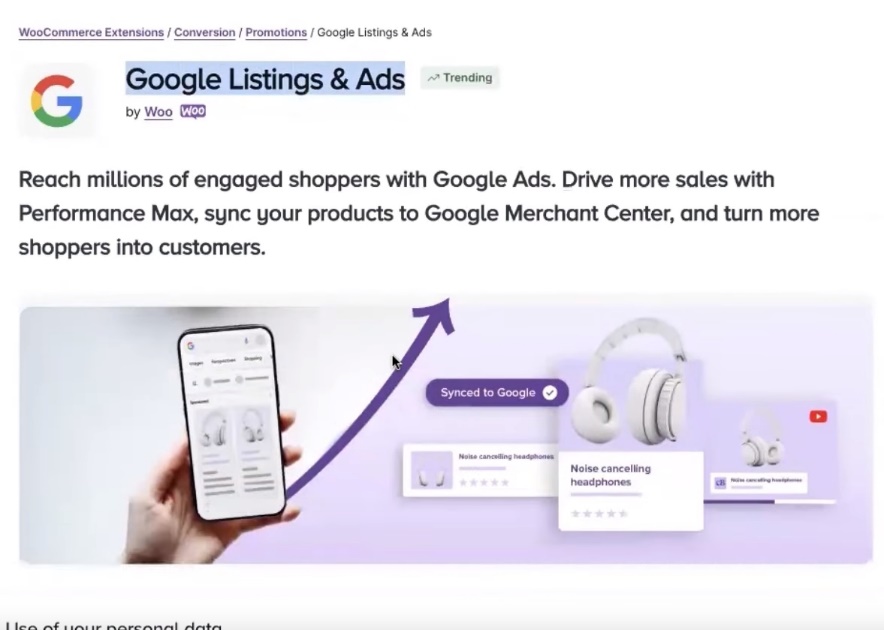
Where do we start? You need to put a plugin on your site called Google Listings & Ads. This is a free plugin, made directly by WooCommerce and Google. This development is a collaboration between them. Google even supports it. Cheapskate. I understand that you may see a rating of 3.7 – quite low. Since we are going through the most budget option, the best option is to use this plugin.
Why this plugin? Through it, it is easy to create Merchant Center, automatically pour all the information into Google Merchant Center and we can create the same Google Ads quite quickly, integration is as easy as possible, fast. Shopify Analog. Shopify boasts that everything is fast – one, two button pushes and it’s done. It’s roughly the same story here.
Installing the Google Listings & Ads plugin
How can we install it on WordPress WooCommerce? We go to “Plugins” here. Click “Add New Plugin”.

You can type in the name of this thing right away, Google will come up with something now. Here it is. Click “Install Now” and now wait for the whole thing to install. Now we need to activate the thing. “Activated.”
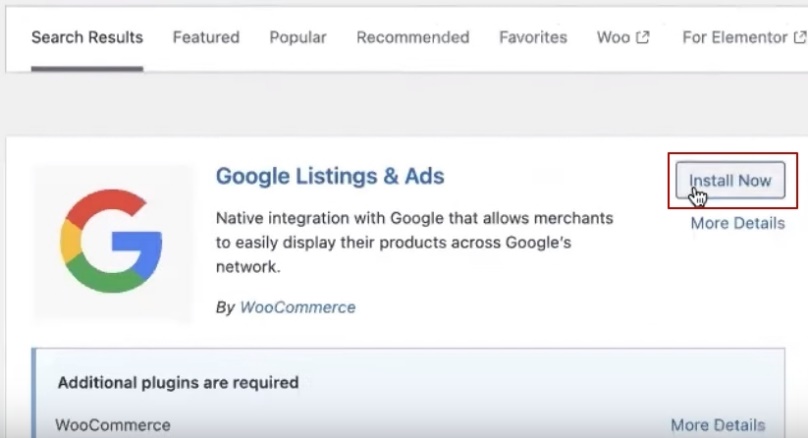
Go to “Plugins”, “Installed Plugins”, look for Google Listings & Ads, click “Get Started” and the fun begins.
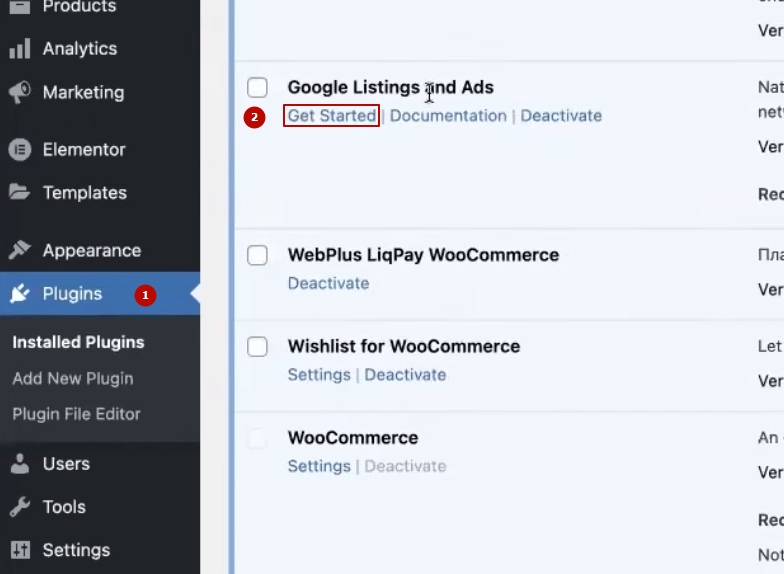
Initially, you’ll see a box like this. “Get millions of customers,” it goes like this. Just a reminder – the integration here will be as light as possible. It will be done by e-mail, everything will be easy to create. The main thing is to go through the stages gradually, one by one.
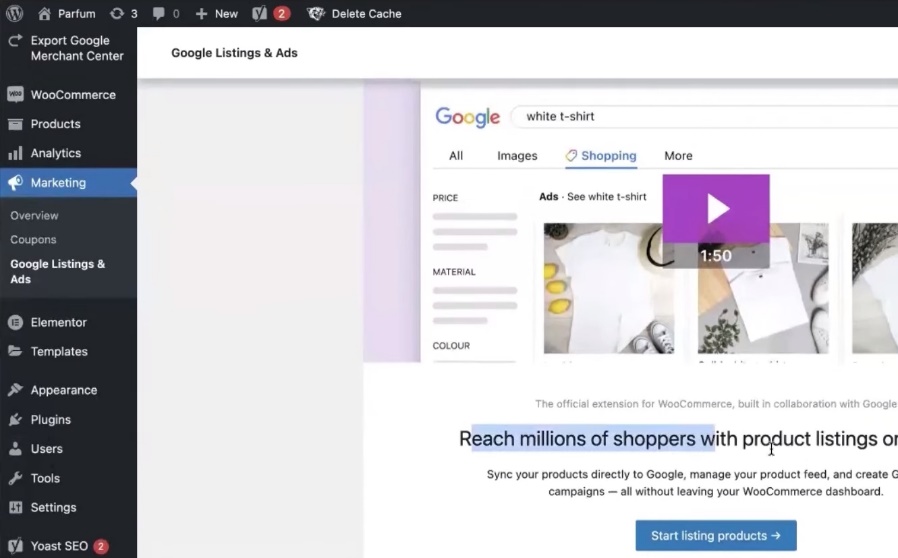
Setting up accounts in the Google Listings & Ads plugin
Click the button “Start listing products”, go further. There will be several stages of customization, nothing complicated. The first thing is we need to set up an account. Here it is important to start with the first step, it is we need to connect our WordPress, respectively, to this plugin.
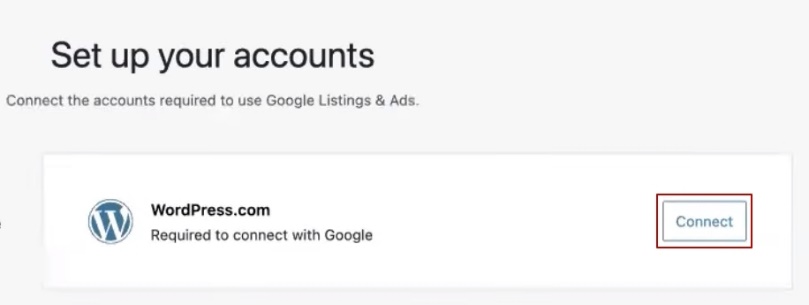
So that there is a connection, respectively, this WordPress with Google history. To do this, it is absolutely necessary to send an e-mail to the admin mail, tied to WordPress and confirm it. I will do it indirectly now.
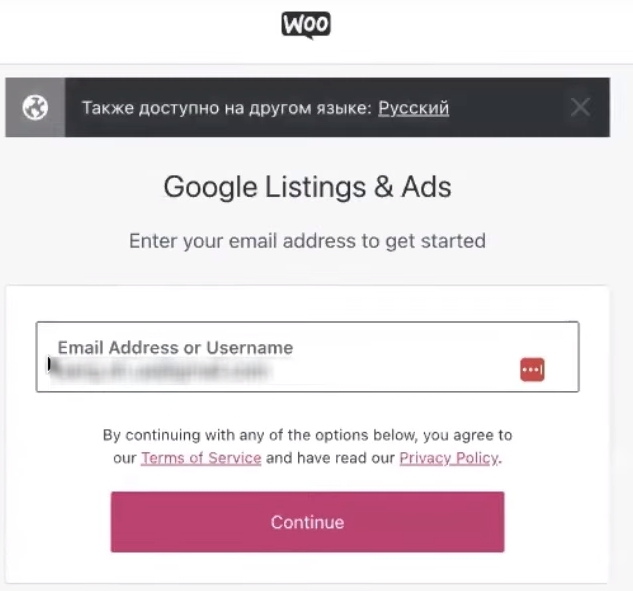
We have passed this verification procedure. Next, we are offered to attach a Google email directly through which Google Merchant Center and Google Ads will be integrated.

I recommend to create a separate email for this story or to know initially under which email you will enter Google Ads and Merchant Center. I click “Connect”, you will be prompted to log in to the appropriate account. I click “Continue”, select all the checkboxes, “Continue”. Now we go on step by step, a little long, but as it is.
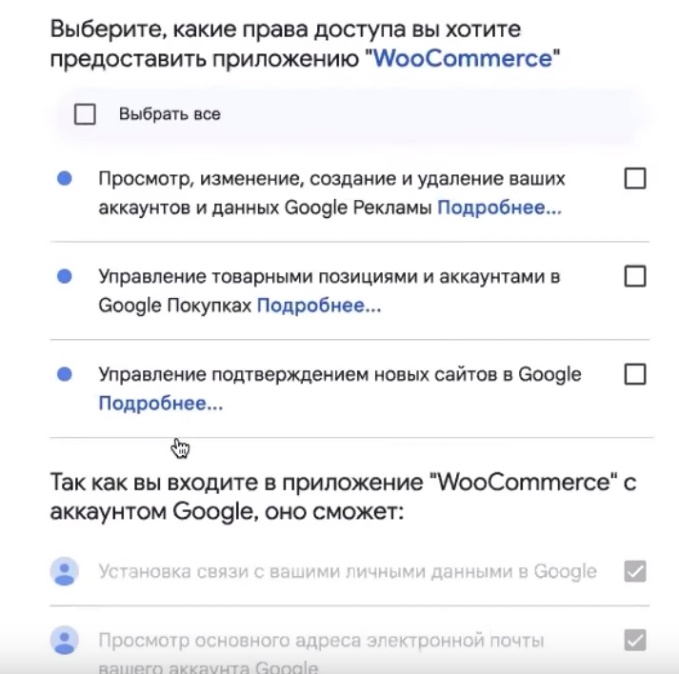
After that Google Merchant Center block. There are several options. If there is already a Merchant Center, conditionally it was created before you started watching the video, then you can choose an existing Merchant Center under the mail under which you have access to this Merchant Center, if you logged in under it at the highest stage.
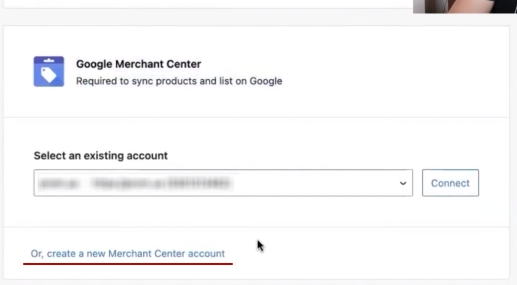
Since there is no existing Merchant Center for the site, but for others. Different Merchant Centers can be logged in under the same e-tag.
I click “Create a new Merchant Center”. I confirm that I’ve read the Terms of Service. Like there’s a choice if I don’t read it differently to create it? The process of creating a new Merchant Center is underway. Just waiting now until the procedure is fully implemented, because without this step we can’t move forward. That’s it. Got it. See – there is the domain name, there is the Merchant Center ID and it says “Connected”. The “Set up your accounts” section will look like this. There should be a green check mark everywhere and it should say “Connected”. Click “Continue” next.

Customizing the “Audience” block
Audience block. It’s important to make time for this. Your settings. The language here is taken directly from the language of the website. It will be translated into English. In this case Ukrainian stands, so you can select Ukrainian and the corresponding countries. What does it affect? It will affect the Performance Max settings in the future, but also the Merchant Center feed settings. Do not click anything, select specifically the country, specifically the language and go on accordingly.

Customizing delivery conditions
Next – “Shipping rates”. What are Shipping rates? These are the shipping settings that will be loaded into the Merchant Center feed plus possibly into the Merchant Center settings. What to choose from the items? Let’s agree, if you start an online store in Ukraine, it is desirable to choose the item called “My shipping settings are complex. I will enter my shipping rates and times manually in Google Merchant Center”, manually enter all settings.

If you are launching in Europe, Australia, Canada, the States, you will use some kind of automatic integration with delivery services. When there is automatic integration with delivery services, then you can leave the “Recommended” block, automatically synchronize shipment settings.
Sometimes it is easier to initially set the delivery settings. If it is easier, then this option may be suitable. You can set the shipping rate at once. Let’s say I leave zero, free shipping on all orders. And how many days. Well, the average in Ukraine is 3 days.

I remind – sometimes it is easier for Ukraine to leave the block and manually set everything directly in the Merchant Center or block “Recommended”, automatic synchronization. If there is: a) automatic integration with delivery services, second – when the cost of delivery depends on weight, volume of some or completely different mechanics of calculation of delivery – choose “Recommended”. I will select a block to show its view directly in the Merchant Center. Click “Continue”.
Providing a telephone number and address
Next, you will be asked to confirm your phone number. Why do I need to confirm my phone number? Remember that the phone number will be linked directly to the Merchant Center. The phone number must be on the website. What does it affect? First, it affects the vetting process. How adequate or inadequate the verification will be. The phone number should be more or less appropriate. I’ll enter the phone number now, confirm, and move on from there.

Store address. Attention! It is desirable that in the address settings, exactly in WooCommerce settings, to specify the correct address, which is needed. There is some abracadabra written, I demonstrate. It is desirable that the address together with the zip code (postal code) is completely similar to what is visually displayed on the site. This is important!

If there are nuances when checking the store – it is better that the information all match and it actually tracked. I miss this point so I don’t waste time on it. If you got all the addresses right, everything is super great. Let’s move on.
Check all the boxes. There’s not much choice. It still won’t let me in without the whole address, so we’ll fill it in. Got it. Click “Continue.” Then go to the next block.
How many calls and sales will I get by ordering contextual advertising from you?
I need to calculate the conversion of my website Describe
the task
in the application
Calculate potential ad revenue Google
contextual advertising calculator

Setting up a campaign with paid advertising
Initially in the “Product feed status”, the product feed will indicate that the product listing is ready to load and will show that there are 27 products in total. Not much, it’s a template site.

Next, you need to connect to Google Ads. If there was already a Google Ads advertising account for the mail under which I logged in at the stage of setting up accounts, it would again offer to select the existing one. I don’t have one, so I will create one. I click “Create account” and it will create an advertising account. See, it offers $500 to spend and get $500 credit.

Let’s move on. We can create advertising campaigns from this stage, or we can skip it. I suggest skipping, if not already checked, directly, Merchant Center. I click “Skip this step” because I’m going to show you an alternative way of creating Performance Max, when you don’t need to hurry, everything is fine in Merchant Center, all conversions are set up. After that you can already create Performance Maxes. Otherwise it makes absolutely no sense at this stage. “Mayby later” and that’s it.
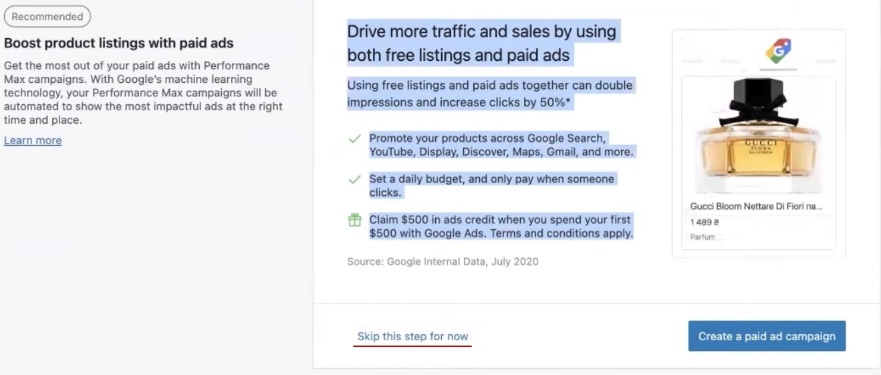
Creating paid advertising campaigns in Google Listings & Ads
Now what do we need to see? The first thing we can see is the “Overview” block. Now it will load information about how many products, how they look like. Various there are reports, dashboard general. Initially loaded only Free Listing, free advertisements. If we want to add a paid block, we can do it in several formats.
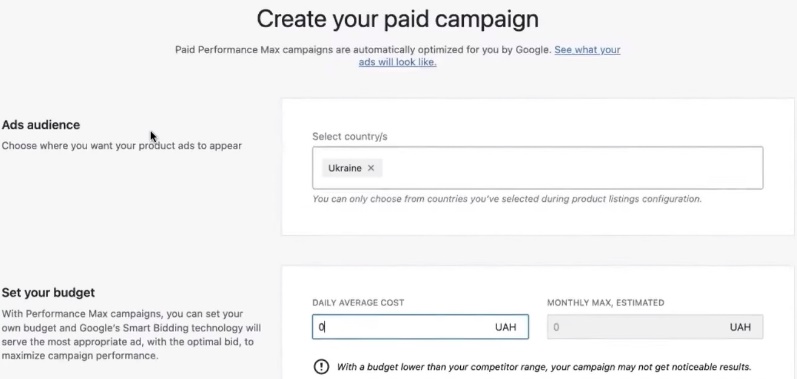
We can click “Add paid”, we can create an ad campaign now some small small campaign.
Or we can go to the Merchant Center. I’ll show you how to enter. Go to the Merchant Center link. “Choose another” account… Here’s the Merchant Center. That’s the one I chose.
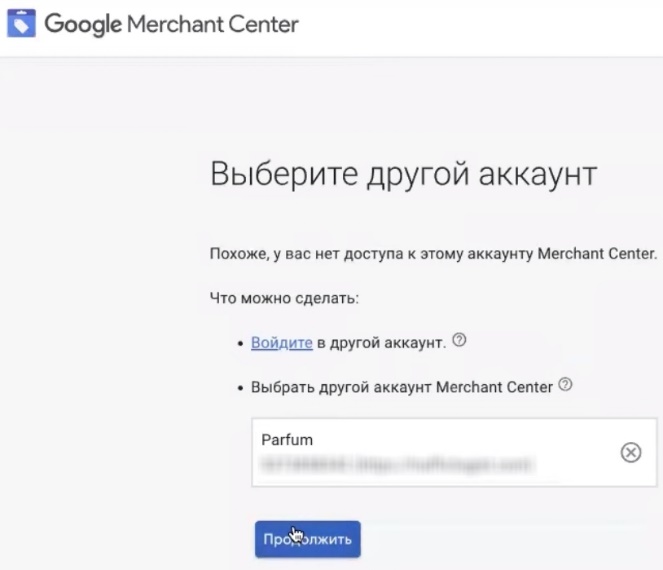
There’s just a few Merchant Centers around here. I go to Parfum. See what’s here? If I go to the products tab in feeds, I see that there is a feed called “Content API”.

If the Merchant Center interface is shown as Merchant Center Next – you can find the feed under “Tools” “Settings”, there will be a drop down menu and “Data Sources”. Select “Sources”, you will see the feed.
You can see that there are three programs, “Display ads” (dynamic remarketing), “Free listings” and “Shopping ads” are enabled at once. Just click this button and the paid program is already connected. Why do I emphasize this? You can start by checking the Merchant Center on free-listing and then add paid advertising.

It’s not hard to add it. You can either go to feeds, Settings, click on the pencil and add the program. Or you can click “Add campaign” here, go through a few steps and it will dive in.
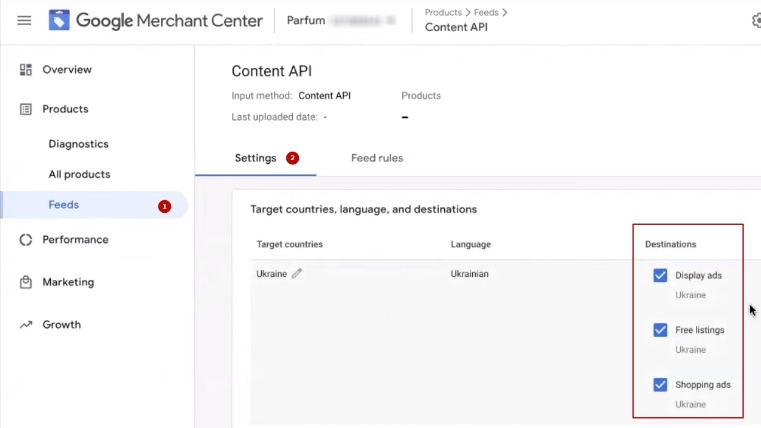
Setting up a feed in Merchant Center
What do we have in this case? We have a grocery feed. You see, a bunch of different products. The settings are basic, you can’t change them in any way. Created Merchant Center. There are already errors because Google Ads is not connected or something. To connect to that we will get to that now. Now in the Merchant Center phase.
Next. As you saw the picture that some goods began to load. I see 27 items are in. They’re all going to check out now, Pending. It’s all going to be a test. May be successful, may not be successful. Remember, it takes 3 days.
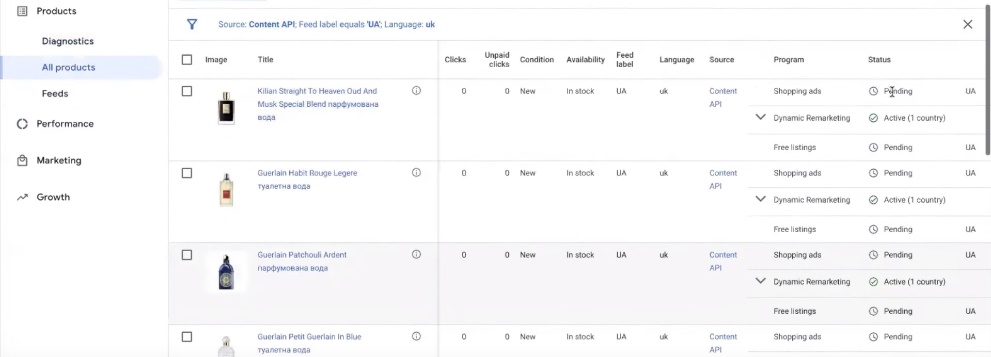
Before you do that, I would recommend going into the settings and going through the shipping settings, check it for business information. If you start in the States, be sure to go through the tax settings. If you are running Merchant Center Next, this panel with shippings and other things is on the left. This is just an old version of Merchant Center.
Checking the specified delivery parameters
I go to the shipping settings and what do we do? Be sure to check if the settings are correct. This is the delivery created automatically when these settings were set. What do we need to check? Be sure to correct all information as it should appear.
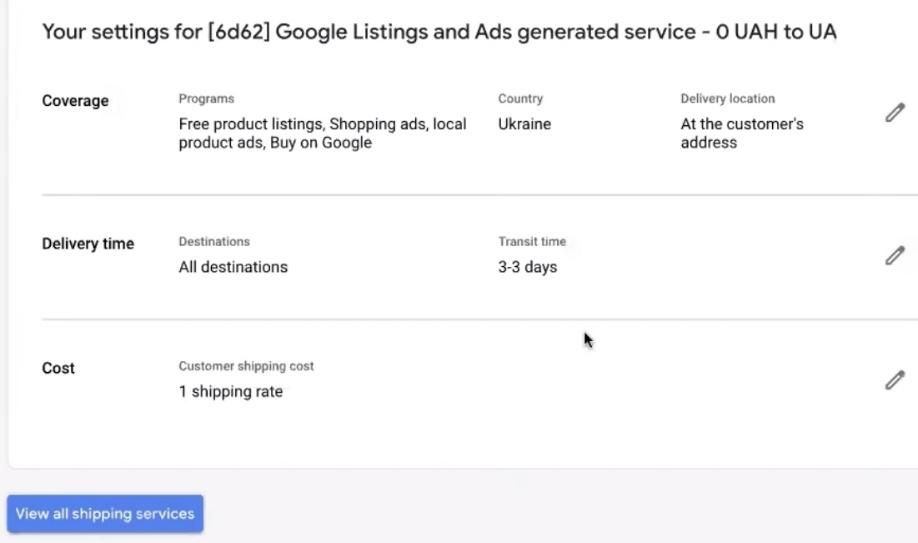
It is necessary to specify the time until which you process orders. The same information must be duplicated on the site in the “Delivery Policy” section. Let’s say Kiev. I choose that until 8 pm. Then make sure you fill in the processing time. Processing time, not delivery time! Until the goods are shipped to the delivery service. Let’s say you process orders around the clock – you can write 0-0. When until 8 pm or 4 pm I take orders and the next day that later came to process, send. I put 0-1. Monday Sunday or Saturday, you set your own work schedule. And Transit time. 1-3 days, specified. You can set the opposite, 2-3 days, depending on the parameters.

I make sure to go into the block and see what is set. Last time I said it would be free, it should be about the same. If you need to redo something, let’s say you need to calculate shipping based on the order value. If you choose weight, you need to load an additional attribute into the feed. It’s not here. Or a product number. You fill it all in. If there is no delivery or something else – you fill out the information based on the established on the site. It is important that the information fully coincides with what is specified in the delivery policy or delivery conditions.
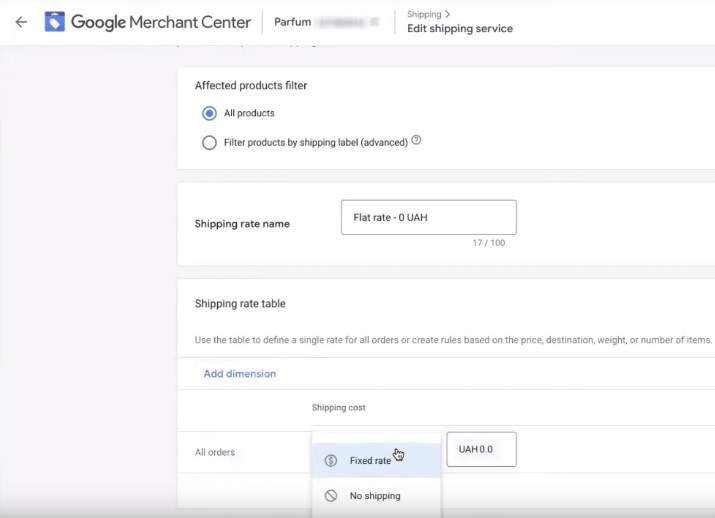
Returns I suggest not to start yet, it is a separate story is better to pass moderation and then to parry with returns.
Tax parameters
Then there’s taxes. It only makes sense to have one in a single country. The only country is the States. It’s whatever you want it to be. You can use a universal one or set your own. For example, select the states, switch to advanced settings. I select all states and set tax rates manually or the system calculates them automatically. Whatever’s convenient. No taxes – I don’t fill this in.
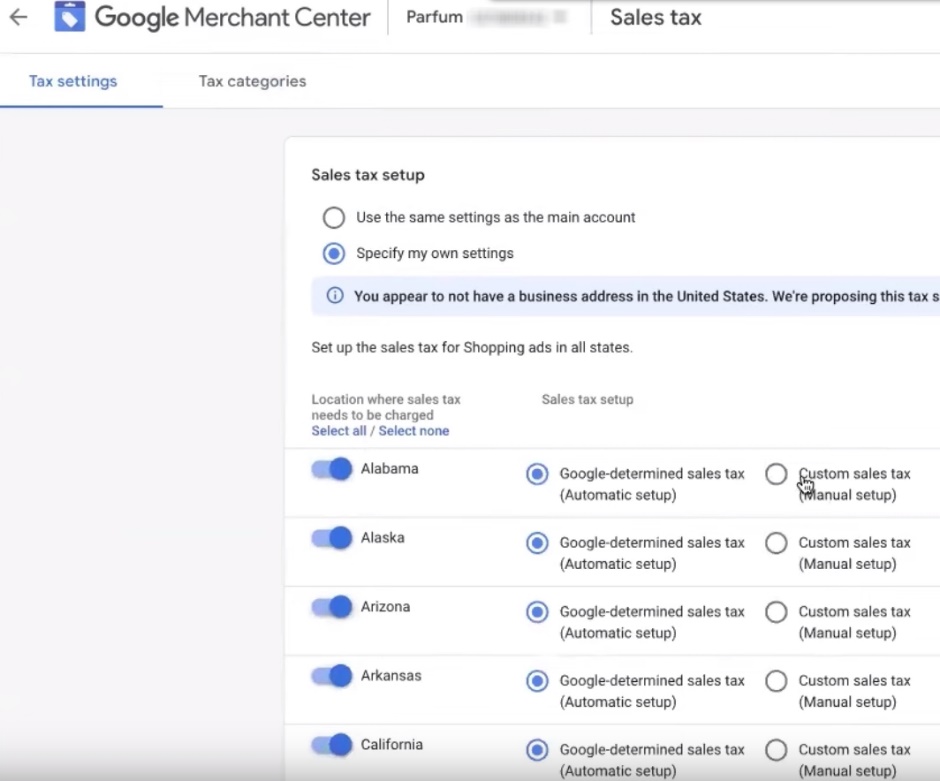
Checking the block of business information
The next block to check is the information about the business. Be sure to check that the name of the store was either a domain name or to write in the name of the domain, in the logos on the site. Next, be sure to check the address. Remember that Kiev is a separate region. It does not specify the Kiev region. The address must fully coincide with that on the site. What you entered in the previous step, but double-check. The same goes for the phone. This block may or may not be filled in. It’s better to be filled in. I’ll leave it out, it’s not crucial.
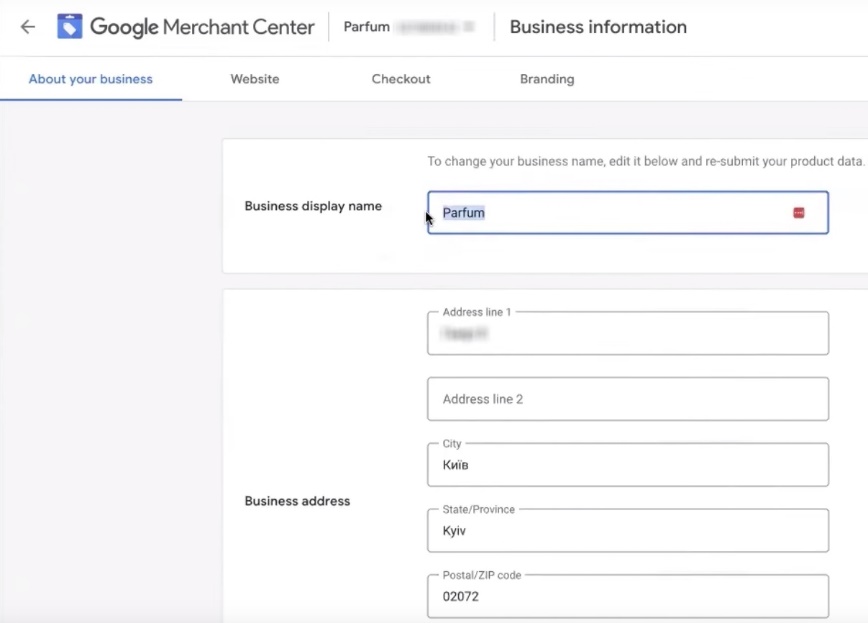
Other store business information
Next, as you can see, is the website tab. All confirmed, all verified. “No checkout. “Branding” – you can skip everything, don’t fill in anything. It’s not critical.
Results of Merchant Center setup
Now at this stage we have Merchant Center, where business information is entered, shipping information is entered and goods are loaded. That’s it. And three programs are enabled: dynamic remarketing, free listing and paid ads. If it’s not enabled, go to the Growth block, called “Manage Programs” and select it.
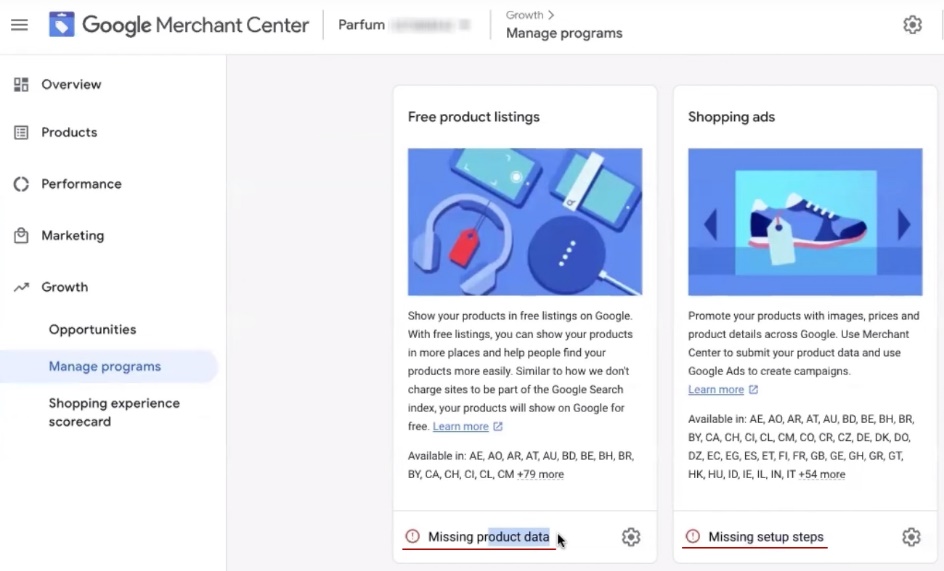
Shoping Ads is missing a certain step. Here product data is missing because products are moderated. Here setup steps because the Google Ads Merchant Center is not connected. But I will explain how to connect them to each other at a later stage.
We are done with the Merchant Center at this stage. Now we’re waiting for the site to be fully checked. As long as they say that everything is fine, we can go on advertising. At the previous stage we created Merchant Center, automatically uploaded products. As from the previous lesson we can see that everything happened easily, literally in a couple of clicks, no need to generate any links. The advantage of this format of uploading data is that if you change the site attributes, name, description or some in the cards of products, then automatically in 15-30 minutes will be in Google Merchant Center. With this format of uploading feed is the least likely to encounter problems with mismatches in price or availability, or other things.
Announcement of the next video – creating analytics, Google Ads
Now we move on to the important stage. The stage will involve the infusion of analytics to run Performance Max and Google Shopping for WordPress, if we say WooCommerce correctly. Where do we need to start? Let’s set up analytics in several important steps. The first stage is to create a fourth analytics account. It will be necessary to be able to further analyze the effectiveness of different sources of traffic to the site. One. Two, it’s possible to evaluate how adaptive the site is or if it has a good enough engagement rate from castomerav (buyers). Right?
The analytics stage, what we’ll do is set up a separate conversion, directly. It will be set up in Google Ads. It will be set up separately, because at the time of shooting the video – June 2024, it is desirable that Performance Max or Google shopping work correctly on the automatic strategy “Profitability”. To transmit advanced conversion data. Advanced conversion data is transferring emails, phone numbers. That sounds complicated so far. It’s actually not super complicated. We’ll go through it step by step, create it. It’s not that complicated. There are a few things that will require a little bit of fiddling. You can, if anything, find an alternative customization option. I show another of the working mechanics, works, least bugs, interruptions with something and, therefore, works almost everywhere. If there is an alternative, you can use it. In this case I show it as it is.








